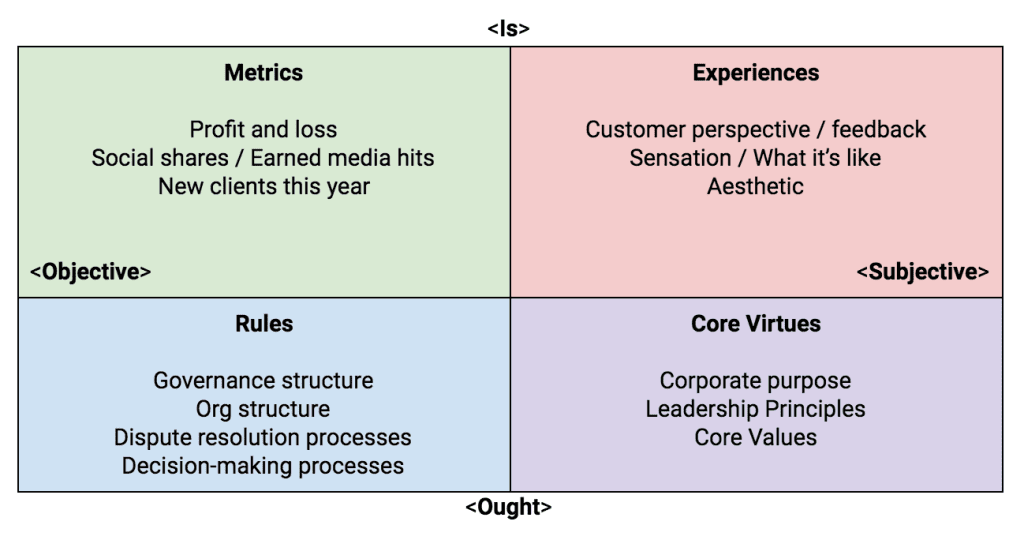By Max Borders
Use Philosophy To Better Understand and Optimize Your Organization

The Integrated Business Matrix
by Max Borders
Philosophers often have a hard time finding work in the business world. But maybe there’s hope for them yet.
We’ve discovered how to use philosophy to bring clarity to any organization using a simple framework that lets leaders ask the right questions.
Whether you’re a high-level CEO or just starting up your own organization, the following is a means of ensuring you understand your organization in its totality.
The Integrated Business Matrix
Using fundamental philosophical categories, you can unpack the basics of your business, as well as probe questions that lie in the overlaps among the categories.
So as not to bury the lede, here’s what the integrated business matrix looks like. In scanning it, you might grok its power straight away. If not, don’t worry. We’ll explain.

Okay, now that you’ve seen the matrix, let’s take a look at how we arrive at it.
Objective to Subjective
First, imagine a line going West to East. On the Western pole write the word “objective.” On the Eastern pole, write the word “subjective.” Got it?
Okay. Now you have a continuum that goes from Objective to Subjective.
In philosophy, objective means more-or-less that which is publicly observable, or better mind independent. Any given person can read a measurement, such as the temperature on a thermometer, or the number of cars parked in the driveway (whatever our opinions). We can get to deeper philosophical questions about knowledge and observation very quickly, but suffice it to say objective is what we think of as belonging to the world around us.
The subjective lies at the other extreme. Here we have phenomena that belong exclusively to someone’s experiences or perspective — that is, their “inner world.” From my tastes and opinions about certain foods or films, to what it’s like to be inside me, seeing things from my point of view. This is the subjective.
All clear? Good.
Is’s to Oughts
Now it’s time for our second line. Only this one goes from North to South, intersecting our first line. At the Northern Pole write the word “Is,” and at the other end write the word “Ought.” The idea here is to make a distinction between facts and values. Facts are bits of information that involve the way the world “is” or maybe the way people are. And values are human commitments to ideas about the way people “ought” to behave.
In philosophy, David Hume made the distinction between facts and values — Is’s and Oughts — because he thought you could not derive a value from a fact. Other philosophers have disagreed with Hume on this question; but it’s good enough for our purposes to separate them conceptually so that we can get to our two poles. And, indeed, “He works as a graphic designer” is a very different kind of statement than “His graphics are amazing.”
Skeptical?
Now it’s true some people would argue that claims of value are just subjective claims, and facts are just objective claims — so that there is no point in having two intersecting continua. But our goal with this is not to solve the world’s philosophical puzzles, but to give us a heuristic.
We want to help people understand their businesses in a more integrated way.
Four Quandrants, Four Categories
If we do, we get a really nice four-quadrant matrix that opens up a simple set of categories that let you explore your business or organization with new lenses.
Metrics – What can I measure in our organization? What are the limits of measurement? (Publicly observable, concerned with facts.)
Experiences – What is it like to interact with our organization, e.g. as a customer, employee, or supplier?
(Perspectival, concerned with facts.)
Rules – What are the structural and operating protocols of our organization?
(Publicly observable, concerned with values.)
Core Virtues – What are the virtues, values and norms that guide our behavior?
(Perspectival, concerned with values.)
Exploring all four categories will take you a lot further in getting a more holistic view of your organization.
A lot of MBAs and organizational types really get Metrics and Rules. And some companies can trundle along focusing mainly on these categories. But the truly great companies deal with all four quadrants equally — integrating them into the DNA of the business.
Getting into the questions of all four quadrants is the difference between having a good organization and a great one — especially as no company can long survive without paying attention to the entire matrix.
Which Businesses Play Best in All Four?
You can take these examples with a grain of salt. But I think they will track pretty well with our intuitions about which organizations take a four-quadrant approach.
- Whole Foods Market
- Pixar
- W. L. Gore & Associates
- The Containers Store
- Riot Games
I won’t bother to name companies that fail to do a good job at all four, but you can probably think of some.
Interesting Overlaps
If you really want to see how deep the rabbit hole goes, think about the areas where these categories might overlap. Not only are these interesting areas, they’re hard areas.
For example, consider what some companies call “knowledge.” Knowledge is part information, which is in the Metrics category, but it is also part perspective — that is, it’s information that will be used by people with various thoughts, feelings, opinions, talents and abilities. It’s right in the overlap. Knowledge management and processes have to take into account both the question of where information is, how it can be accessed, by whom and for whom — to be used how.
Take another example: Lots of companies have Vision Statements and Core Values. But so often these are just soulless corporate slogans that get printed by the HR department, seen on the first day, and never get mentioned again until the company picnic. As such, no one is looking at where the company’s core values are intersecting with the experiential–i.e. the meaningful. That is, how do your employees, customers and suppliers perceive your commitment to your values? Do they animate your activities? Do they leave everyone with a sense of something special — even palpable — in their interactions with your organization?
Holism
Remember, the key thing about successful organizations is that they are holistic and integrated. This may sound a little woo woo to some–just as talk of metrics and org charts may seem boring to artists and creatives. But the more we appreciate the full picture of our organizations, the more likely we are to create real value for ourselves, our customers, our team members and, hopefully, the wider world.
Max Borders is co-founder and co-CEO of Voice & Exit.



